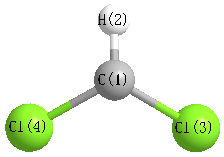Jump to
S1C2
Energy calculated at QCISD/3-21G
| | hartrees |
|---|
| Energy at 0K | -952.944651 |
| Energy at 298.15K | |
| HF Energy | -952.751404 |
| Nuclear repulsion energy | 118.622226 |
The energy at 298.15K was derived from the energy at 0K
and an integrated heat capacity that used the calculated vibrational frequencies.
Vibrational Frequencies calculated at QCISD/3-21G
| Mode Number |
Symmetry |
Frequency
(cm-1) |
Scaled Frequency
(cm-1) |
IR Intensities
(km mol-1) |
Raman Act
(Å4/u) |
Dep P |
Dep U |
|---|
| 1 |
A1 |
3288 |
3186 |
1.37 |
|
|
|
| 2 |
A1 |
620 |
601 |
11.99 |
|
|
|
| 3 |
A1 |
261 |
253 |
0.87 |
|
|
|
| 4 |
B1 |
485i |
470i |
80.85 |
|
|
|
| 5 |
B2 |
1170 |
1134 |
69.86 |
|
|
|
| 6 |
B2 |
779 |
755 |
99.82 |
|
|
|
Unscaled Zero Point Vibrational Energy (zpe) 2815.9 cm
-1
Scaled (by 0.9692) Zero Point Vibrational Energy (zpe) 2729.2 cm
-1
See section
III.C.1 List or set vibrational scaling factors
to change the scale factors used here.
See section
III.C.2
Calculate a vibrational scaling factor for a given set of molecules
to determine the least squares best scaling factor.
Geometric Data calculated at QCISD/3-21G
Point Group is C2v
Cartesians (Å)
| Atom |
x (Å) |
y (Å) |
z (Å) |
|---|
| C1 |
0.000 |
0.000 |
0.738 |
| H2 |
0.000 |
0.000 |
1.817 |
| Cl3 |
0.000 |
1.560 |
-0.184 |
| Cl4 |
0.000 |
-1.560 |
-0.184 |
Atom - Atom Distances (Å)
| |
C1 |
H2 |
Cl3 |
Cl4 |
| C1 | | 1.0791 | 1.8120 | 1.8120 |
H2 | 1.0791 | | 2.5371 | 2.5371 | Cl3 | 1.8120 | 2.5371 | | 3.1202 | Cl4 | 1.8120 | 2.5371 | 3.1202 | |
 More geometry information
More geometry information
Calculated Bond Angles
| atom1 |
atom2 |
atom3 |
angle |
|
atom1 |
atom2 |
atom3 |
angle |
| Cl3 |
C1 |
H2 |
120.573 |
|
Cl3 |
C1 |
Cl4 |
118.854 |
| Cl4 |
C1 |
H2 |
120.573 |
|
Electronic energy levels
Charges, Dipole, Quadrupole and Polarizability
Jump to
S1C1
Energy calculated at QCISD/3-21G
| | hartrees |
|---|
| Energy at 0K | -952.946946 |
| Energy at 298.15K | -952.947629 |
| HF Energy | -952.753077 |
| Nuclear repulsion energy | 118.096984 |
The energy at 298.15K was derived from the energy at 0K
and an integrated heat capacity that used the calculated vibrational frequencies.
Vibrational Frequencies calculated at QCISD/3-21G
| Mode Number |
Symmetry |
Frequency
(cm-1) |
Scaled Frequency
(cm-1) |
IR Intensities
(km mol-1) |
Raman Act
(Å4/u) |
Dep P |
Dep U |
|---|
| 1 |
A' |
3229 |
3130 |
1.31 |
|
|
|
| 2 |
A' |
677 |
656 |
26.69 |
|
|
|
| 3 |
A' |
536 |
519 |
10.83 |
|
|
|
| 4 |
A' |
260 |
252 |
0.65 |
|
|
|
| 5 |
A" |
1196 |
1159 |
44.51 |
|
|
|
| 6 |
A" |
736 |
713 |
130.27 |
|
|
|
Unscaled Zero Point Vibrational Energy (zpe) 3316.7 cm
-1
Scaled (by 0.9692) Zero Point Vibrational Energy (zpe) 3214.6 cm
-1
See section
III.C.1 List or set vibrational scaling factors
to change the scale factors used here.
See section
III.C.2
Calculate a vibrational scaling factor for a given set of molecules
to determine the least squares best scaling factor.
Geometric Data calculated at QCISD/3-21G
Point Group is Cs
Cartesians (Å)
| Atom |
x (Å) |
y (Å) |
z (Å) |
|---|
| C1 |
0.015 |
0.780 |
0.000 |
| H2 |
-0.611 |
1.665 |
0.000 |
| Cl3 |
0.015 |
-0.187 |
1.558 |
| Cl4 |
0.015 |
-0.187 |
-1.558 |
Atom - Atom Distances (Å)
| |
C1 |
H2 |
Cl3 |
Cl4 |
| C1 | | 1.0842 | 1.8332 | 1.8332 |
H2 | 1.0842 | | 2.4993 | 2.4993 | Cl3 | 1.8332 | 2.4993 | | 3.1158 | Cl4 | 1.8332 | 2.4993 | 3.1158 | |
 More geometry information
More geometry information
Calculated Bond Angles
| atom1 |
atom2 |
atom3 |
angle |
|
atom1 |
atom2 |
atom3 |
angle |
| Cl3 |
C1 |
H2 |
115.481 |
|
Cl3 |
C1 |
Cl4 |
116.390 |
| Cl4 |
C1 |
H2 |
115.481 |
|
Electronic energy levels
Charges, Dipole, Quadrupole and Polarizability
